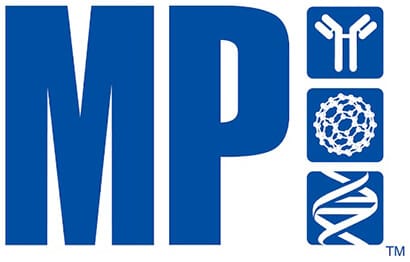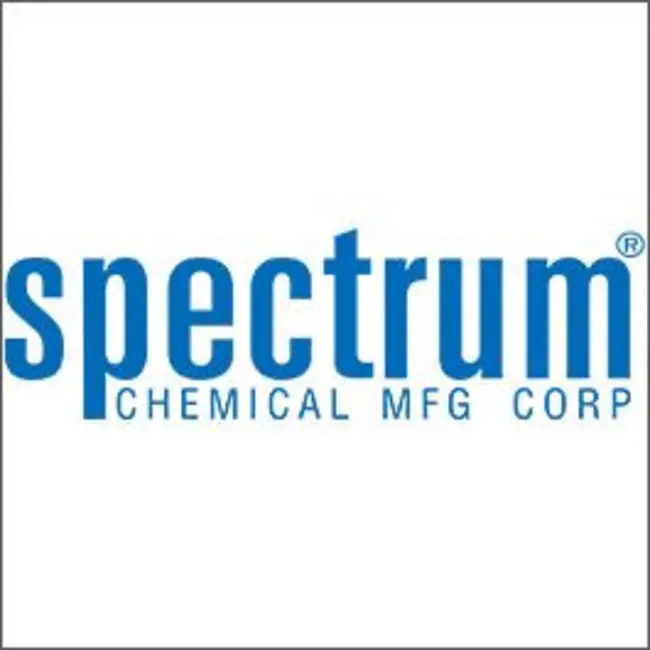GenScript Biotech
Showing 351–400 of 2554 results
-
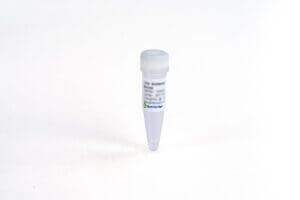
Calcitonin (12C5), mAb, Mouse
$11,126.25 Add to cart View Product DetailsPCT, a 116 amino acid (aa) protein, is comprised of three sections including a 57 aa N-terminal PCT, a 32 aa calcitonin and a 21 aa katacalcin. Calcitonin is a hormone, derived from PCT cleavage. PCT is a good diagnosis marker for bacterial infection. Other diseases such as sepsis, inflammation, surgery, heat shock, burn injuries and cardiogenic shock can also cause an increase of PCT level in blood.
-

Calcitonin (E72), mAb, Mouse
$131.10 Add to cart View Product DetailsPCT is a 116 amino acid (aa) protein. It is comprised of three sections of a 57 aa N-terminal PCT, a 32 aa calcitonin and a 21 aa katacalcin. Calcitonin is a hormone, derived from PCT cleavage. PCT is a good diagnosis marker for bacterial infection. Other diseases such as sepsis, inflammation, surgery, heat shock, burn injuries and cardiogenic shock can also cause an increase of PCT level in blood.
-

Calcitonin (E72), mAb, Mouse
$1,311.00 Add to cart View Product DetailsPCT is a 116 amino acid (aa) protein. It is comprised of three sections of a 57 aa N-terminal PCT, a 32 aa calcitonin and a 21 aa katacalcin. Calcitonin is a hormone, derived from PCT cleavage. PCT is a good diagnosis marker for bacterial infection. Other diseases such as sepsis, inflammation, surgery, heat shock, burn injuries and cardiogenic shock can also cause an increase of PCT level in blood.
-

Calcitonin (E72), mAb, Mouse
$11,126.25 Add to cart View Product DetailsPCT is a 116 amino acid (aa) protein. It is comprised of three sections of a 57 aa N-terminal PCT, a 32 aa calcitonin and a 21 aa katacalcin. Calcitonin is a hormone, derived from PCT cleavage. PCT is a good diagnosis marker for bacterial infection. Other diseases such as sepsis, inflammation, surgery, heat shock, burn injuries and cardiogenic shock can also cause an increase of PCT level in blood.
-

cAMP ELISA Detection Kit
$256.16 Add to cart View Product DetailsKit Description
GenScript cAMP ELISA Detection Kit is a competition enzyme-linked immunoassay which can be used for quantitative detection of cAMP (Adenosine 3′,5′-cyclic monophosphate) in samples such as serum, plasma, saliva, cell culture supernatant, and urine. cAMP is an important secondary messenger in signal transduction pathways that follows a number of extracellular signals. cAMP activates or inhibits various enzymes by promoting their phosphorylation or dephosphorylation. Its concentration is converted from adenosine triphosphate (ATP) via adenylyl cyclases (AC), and is inactivated by hydrolysis to 5′-AMP by the actions of phosphodiesterases.
The anti-IgG Capture Plate is pre-coated with a fixed amount of Goat anti-mouse IgG to capture Mouse Anti-cAMP Monoclonal Antibody. When free cAMP or specimen and HRP-cAMP are added to the well, they compete in the solution to interact with the cAMP antibody captured on the plate. Other unbound molecules are removed by the wash step. The cAMP-HRP reacts with TMB substrate to develop a blue product in the solution. The reaction is stopped by adding stop solution and the color turns yellow which can be read at 450 nm by a Microtiter plate reader. Using the standard curve, the cAMP amount present in the unknown samples can be calculated by transforming its absorbance value.
-

cAMP-HRP
$94.01 Add to cart View Product DetailscAMP-peroxidase conjugate is a product most suitable for GenScript’s THETM Anti cAMP monoclonal antibody (Cat. No. A01509) and Rabbit Anti-cAMP polyclonal antibody (Cat. No. A00614) in immunoassay development for cAMP detection. HRP is conjugated to the C-8 position of cAMP.
-
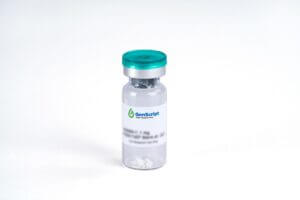
Cardiac Troponin I (cTnI), His, Human
$1,543.88 Add to cart View Product DetailsCardiac Troponin I (cTnI) is a subtype of the troponin family that is commonly used as a marker for myocardial damage. Cardiac troponin I is specific for cardiac tissue and is detected in the serum only if myocardial injury has occurred. Because cardiac troponin I is a very sensitive and specific indicator of heart muscle (myocardium) damage, serum levels can be used to help differentiate between unstable angina and myocardial infarction (heart attack) in people with chest pain or acute coronary syndrome.
-

Cardiac Troponin I (cTnI), His, Human
$43.13 Add to cart View Product DetailsCardiac Troponin I (cTnI) is a subtype of the troponin family that is commonly used as a marker for myocardial damage. Cardiac troponin I is specific for cardiac tissue and is detected in the serum only if myocardial injury has occurred. Because cardiac troponin I is a very sensitive and specific indicator of heart muscle (myocardium) damage, serum levels can be used to help differentiate between unstable angina and myocardial infarction (heart attack) in people with chest pain or acute coronary syndrome.
-
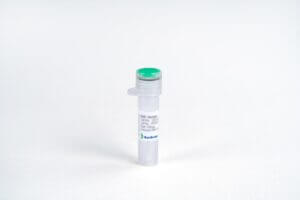
Cardiac Troponin I (cTnI), His, Human
$99.19 Add to cart View Product DetailsCardiac Troponin I (cTnI) is a subtype of the troponin family that is commonly used as a marker for myocardial damage. Cardiac troponin I is specific for cardiac tissue and is detected in the serum only if myocardial injury has occurred. Because cardiac troponin I is a very sensitive and specific indicator of heart muscle (myocardium) damage, serum levels can be used to help differentiate between unstable angina and myocardial infarction (heart attack) in people with chest pain or acute coronary syndrome.
-
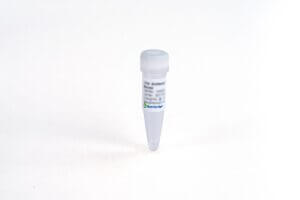
Cardiac Troponin T (cTnT) Antibody (12F6), mAb, Mouse
$140.59 Add to cart View Product DetailsCardiac
TnT (cTnT) is the largest subunit of the troponin complex which is composed of
cTnT, troponin I (TnI), troponin C (TnC). It is encoded by the TNNT2 gene with
a calculated molecular weight of 34.6 kDa. The cTnT is considered as a useful
biomarker for the diagnosis of acute myocardial infarction. -

Cardiac Troponin T (cTnT) Antibody (12F6), mAb, Mouse
$1,405.88 Add to cart View Product DetailsCardiac
TnT (cTnT) is the largest subunit of the troponin complex which is composed of
cTnT, troponin I (TnI), troponin C (TnC). It is encoded by the TNNT2 gene with
a calculated molecular weight of 34.6 kDa. The cTnT is considered as a useful
biomarker for the diagnosis of acute myocardial infarction. -

Cardiac Troponin T (cTnT) Antibody (12F6), mAb, Mouse
$11,947.35 Add to cart View Product DetailsCardiac
TnT (cTnT) is the largest subunit of the troponin complex which is composed of
cTnT, troponin I (TnI), troponin C (TnC). It is encoded by the TNNT2 gene with
a calculated molecular weight of 34.6 kDa. The cTnT is considered as a useful
biomarker for the diagnosis of acute myocardial infarction. -

Cardiac Troponin T (cTnT) Antibody (1H5C2), mAb, Mouse
$140.59 Add to cart View Product DetailsCardiac TnT (cTnT) is the largest subunit of the troponin complex which is composed of cTnT, troponin I (TnI), troponin C (TnC). It is encoded by the TNNT2 gene with a calculated molecular weight of 34.6 kDa. The cTnT is considered as a useful biomarker for the diagnosis of acute myocardial infarction.
-
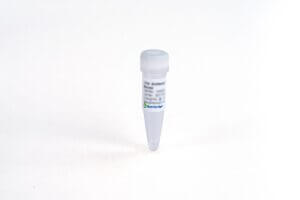
Cardiac Troponin T (cTnT) Antibody (1H5C2), mAb, Mouse
$1,405.88 Add to cart View Product DetailsCardiac TnT (cTnT) is the largest subunit of the troponin complex which is composed of cTnT, troponin I (TnI), troponin C (TnC). It is encoded by the TNNT2 gene with a calculated molecular weight of 34.6 kDa. The cTnT is considered as a useful biomarker for the diagnosis of acute myocardial infarction.
-

Cardiac Troponin T (cTnT) Antibody (1H5C2), mAb, Mouse
$11,947.35 Add to cart View Product DetailsCardiac TnT (cTnT) is the largest subunit of the troponin complex which is composed of cTnT, troponin I (TnI), troponin C (TnC). It is encoded by the TNNT2 gene with a calculated molecular weight of 34.6 kDa. The cTnT is considered as a useful biomarker for the diagnosis of acute myocardial infarction.
-

Cardiac Troponin T (cTnT) Antibody (4B6), mAb, Mouse
$140.59 Add to cart View Product DetailsCardiac TnT (cTnT) is the largest subunit of the troponin complex which is composed of cTnT, troponin I (TnI), troponin C (TnC). It is encoded by the TNNT2 gene with a calculated molecular weight of 34.6 kDa. The cTnT is considered as a useful biomarker for the diagnosis of acute myocardial infarction.
-

Cardiac Troponin T (cTnT) Antibody (4B6), mAb, Mouse
$1,405.88 Add to cart View Product DetailsCardiac TnT (cTnT) is the largest subunit of the troponin complex which is composed of cTnT, troponin I (TnI), troponin C (TnC). It is encoded by the TNNT2 gene with a calculated molecular weight of 34.6 kDa. The cTnT is considered as a useful biomarker for the diagnosis of acute myocardial infarction.
-
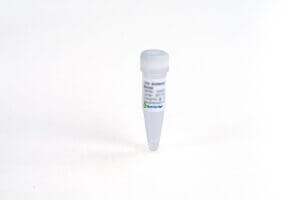
Cardiac Troponin T (cTnT) Antibody (4B6), mAb, Mouse
$11,948.21 Add to cart View Product DetailsCardiac TnT (cTnT) is the largest subunit of the troponin complex which is composed of cTnT, troponin I (TnI), troponin C (TnC). It is encoded by the TNNT2 gene with a calculated molecular weight of 34.6 kDa. The cTnT is considered as a useful biomarker for the diagnosis of acute myocardial infarction.
-

Cardiac Troponin T (cTnT) Antibody (4B6H2), mAb, Mouse
$140.59 Add to cart View Product DetailsCardiac
TnT (cTnT) is the largest subunit of the troponin complex which is composed of
cTnT, troponin I (TnI), troponin C (TnC). It is encoded by the TNNT2 gene with
a calculated molecular weight of 34.6 kDa. The cTnT is considered as a useful
biomarker for the diagnosis of acute myocardial infarction. -

Cardiac Troponin T (cTnT) Antibody (4B6H2), mAb, Mouse
$1,405.88 Add to cart View Product DetailsCardiac
TnT (cTnT) is the largest subunit of the troponin complex which is composed of
cTnT, troponin I (TnI), troponin C (TnC). It is encoded by the TNNT2 gene with
a calculated molecular weight of 34.6 kDa. The cTnT is considered as a useful
biomarker for the diagnosis of acute myocardial infarction. -

Cardiac Troponin T (cTnT) Antibody (4B6H2), mAb, Mouse
$11,947.35 Add to cart View Product DetailsCardiac
TnT (cTnT) is the largest subunit of the troponin complex which is composed of
cTnT, troponin I (TnI), troponin C (TnC). It is encoded by the TNNT2 gene with
a calculated molecular weight of 34.6 kDa. The cTnT is considered as a useful
biomarker for the diagnosis of acute myocardial infarction. -

Cassette Opener
$10.35 Add to cart View Product DetailsThe gel opener is used to open ExpressPlusᵀᴹ or SurePAGEᵀᴹ gel cassette after gel electrophoresis.
-

Cathepsin B, His, Human
$142.31 Add to cart View Product DetailsCathepsin B is an enzymatic protein that is a member of the peptidase (or protease) family. Elevated lev- els of cathepsin B occur in a wide variety of disease,causing numerous pathologies including cell death, inflammation, and the production of toxic peptides. For example, neuroscience research suggests that cathepsin B plays a role in inducing epilepsy resulting in a significant amount of cell death. Seizure-induced rats treated with a cathepsin B inhibitor exhibited improved neurological scores and learning ability with reduced neuronal cell death.
-

Cathepsin B, Human
$3,540.56 Add to cart View Product DetailsCathepsin B is an enzymatic protein belonging to the peptidase (or protease) families. The protein encoded by this gene is a lysosomal cysteine protease composed of a dimer of disulfide-linked heavy and light chains, both produced from a single protein precursor. It is a member of the peptidase C1 family. At least five transcript variants encoding the same protein have been found for this gene. Cystatin-B / CSTB is an intracellular thiol proteinase inhibitor. Tightly binding reversible inhibitor of cathepsins L, H and B. Cystatin-B / CSTB is able to form a dimer stabilized by noncovalent forces, inhibiting papain and cathepsins l, h and b. Cystatin-B / CSTB is also thought to play a role in protecting against the proteases leaking from lysosomes.
-

Cathepsin B, Human
$780.56 Add to cart View Product DetailsCathepsin B is an enzymatic protein belonging to the peptidase (or protease) families. The protein encoded by this gene is a lysosomal cysteine protease composed of a dimer of disulfide-linked heavy and light chains, both produced from a single protein precursor. It is a member of the peptidase C1 family. At least five transcript variants encoding the same protein have been found for this gene. Cystatin-B / CSTB is an intracellular thiol proteinase inhibitor. Tightly binding reversible inhibitor of cathepsins L, H and B. Cystatin-B / CSTB is able to form a dimer stabilized by noncovalent forces, inhibiting papain and cathepsins l, h and b. Cystatin-B / CSTB is also thought to play a role in protecting against the proteases leaking from lysosomes.
-

Cathepsin L, Human
$2,070.00 Add to cart View Product DetailsCathepsin L is an enzyme. Cathepsin L, a lysosomal endopeptidase expressed in most eukaryotic cells, is a member of the papain-like family of cysteine proteinases. Cathepsin L plays a major role in antigen processing, tumor invasion and metastasis, bone resorption, and turnover of intracellular and secreted proteins involved in growth regulation. Unlike the precursor forms of other papain family members, the 43 kDa pro-cathepsin L itself is secreted from various cells. Pro-cathepsin L is the major excreted protein of malignantly transformed mouse fibroblasts and is also one of the major acidic cysteine proteases in mammalian cells.
-

Cathepsin L, Human
$81.94 Add to cart View Product DetailsCathepsin L is an enzyme. Cathepsin L, a lysosomal endopeptidase expressed in most eukaryotic cells, is a member of the papain-like family of cysteine proteinases. Cathepsin L plays a major role in antigen processing, tumor invasion and metastasis, bone resorption, and turnover of intracellular and secreted proteins involved in growth regulation. Unlike the precursor forms of other papain family members, the 43 kDa pro-cathepsin L itself is secreted from various cells. Pro-cathepsin L is the major excreted protein of malignantly transformed mouse fibroblasts and is also one of the major acidic cysteine proteases in mammalian cells.
-

Cathepsin L, Human
$266.51 Add to cart View Product DetailsCathepsin L is an enzyme. Cathepsin L, a lysosomal endopeptidase expressed in most eukaryotic cells, is a member of the papain-like family of cysteine proteinases. Cathepsin L plays a major role in antigen processing, tumor invasion and metastasis, bone resorption, and turnover of intracellular and secreted proteins involved in growth regulation. Unlike the precursor forms of other papain family members, the 43 kDa pro-cathepsin L itself is secreted from various cells. Pro-cathepsin L is the major excreted protein of malignantly transformed mouse fibroblasts and is also one of the major acidic cysteine proteases in mammalian cells.
-
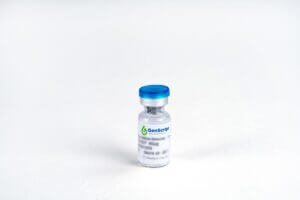
CBP Tag Antibody, mAb, Mouse
$87.98 Add to cart View Product DetailsGenScript CBP Tag Antibody, mAb, Mouse recognizes CBP-tagged proteins.
-

CBP-tag Antibody, pAb, Rabbit
$87.98 Add to cart View Product DetailsGenScript CBP-tag Antibody recognizes CBP tagged fusion proteins.
-

CCL25, Mouse
$2,518.50 Add to cart View Product DetailsCCL25 is a new member of the CC family chemokine. It is also called Thymus-expressed chemokine (TECK) because it is restricted produced by thymus and intestine. Especially, the dendritic cells derived from thymus but not bone marrow had been identified to be the source of CCL25. By binding with CCR9, it elicits its effects of chemotactic for thymocytes, macrophages, and dendritic cells. Additionally, CCL25 takes part in regulating the development of T-cells.
-

CCL25, Mouse
$521.81 Add to cart View Product DetailsCCL25 is a new member of the CC family chemokine. It is also called Thymus-expressed chemokine (TECK) because it is restricted produced by thymus and intestine. Especially, the dendritic cells derived from thymus but not bone marrow had been identified to be the source of CCL25. By binding with CCR9, it elicits its effects of chemotactic for thymocytes, macrophages, and dendritic cells. Additionally, CCL25 takes part in regulating the development of T-cells.
-

CD160 Fc Chimera, Human
$1,035.00 Add to cart View Product DetailsCD160 is a glycosylphosphatidylinositol-anchored Ig domain protein that is expressed on almost all intestinal intraepithelial lymphocytes (IELs), γδ T (gamma delta T) cells, NK (natural killer) cells, and a minor subset of CD4+ and CD8+ T cells. In terms of function, work has centered on the role of CD160 in enhancing NK or CD8 T cell activation. Such effects have been attributed to the ability of CD160 to bind classical and nonclassical MHC class I molecules, although with apparent low affinity, requiring clustering of MHC class I molecules or overexpression of CD160 or MHC class I for detection of the interaction.
-

CD160 Fc Chimera, Human
$34.50 Add to cart View Product DetailsCD160 is a glycosylphosphatidylinositol-anchored Ig domain protein that is expressed on almost all intestinal intraepithelial lymphocytes (IELs), γδ T (gamma delta T) cells, NK (natural killer) cells, and a minor subset of CD4+ and CD8+ T cells. In terms of function, work has centered on the role of CD160 in enhancing NK or CD8 T cell activation. Such effects have been attributed to the ability of CD160 to bind classical and nonclassical MHC class I molecules, although with apparent low affinity, requiring clustering of MHC class I molecules or overexpression of CD160 or MHC class I for detection of the interaction.
-

CD160 Fc Chimera, Human
$103.50 Add to cart View Product DetailsCD160 is a glycosylphosphatidylinositol-anchored Ig domain protein that is expressed on almost all intestinal intraepithelial lymphocytes (IELs), γδ T (gamma delta T) cells, NK (natural killer) cells, and a minor subset of CD4+ and CD8+ T cells. In terms of function, work has centered on the role of CD160 in enhancing NK or CD8 T cell activation. Such effects have been attributed to the ability of CD160 to bind classical and nonclassical MHC class I molecules, although with apparent low affinity, requiring clustering of MHC class I molecules or overexpression of CD160 or MHC class I for detection of the interaction.
-

CD19 Fc Chimera, Human
$1,293.75 Add to cart View Product DetailsCD19 is a 95 kDa coreceptor, which amplifies the signaling cascade in B cells. On the B cell surface, CD19 associates with CD21, CD81 and Leu-13 to exert its function. The cytoplasmic tail of CD19 has nine conserved tyrosine residues playing critical roles in CD19 mediated function by coupling signaling molecules to the receptor. Mature human CD19 consists of a 272aa extracellular domain (ECD) with two Ig-like domains, a 22aa transmembrane segment, and a 243aa cytoplasmic domain.
-

CD19 Fc Chimera, Human
$237.19 Add to cart View Product DetailsCD19 is a 95 kDa coreceptor, which amplifies the signaling cascade in B cells. On the B cell surface, CD19 associates with CD21, CD81 and Leu-13 to exert its function. The cytoplasmic tail of CD19 has nine conserved tyrosine residues playing critical roles in CD19 mediated function by coupling signaling molecules to the receptor. Mature human CD19 consists of a 272aa extracellular domain (ECD) with two Ig-like domains, a 22aa transmembrane segment, and a 243aa cytoplasmic domain.
-

CD20, His & Avi, Human
$301.88 Add to cart View Product DetailsB-lymphocyte antigen CD20 or CD20 is an activated-glycosylated phosphoprotein expressed on the surface of all B-cells beginning at the pro-B phase (CD45R , CD117 ) and progressively increasing in concentration until maturity.CD20 is the target of the monoclonal antibodies rituximab, ocrelizumab, obinutuzumab, ofatumumab, ibritumomab tiuxetan, tositumomab, and ublituximab, which are all active agents in the treatment of all B cell lymphomas, leukemias, and B cell-mediated autoimmune diseases.
-

CD200 R1, His, Human
$241.50 Add to cart View Product DetailsCell surface glycoprotein CD200 Receptor 1 (CD200R1) is the receptor for the CD200 (OX-2) membrane glycoprotein. CD200R1 contains one C2- type Ig-like domain and one V-type Ig-like domain within its extracellular domain and a PTB-signaling motif in cytoplasmic domain. CD200R1 and CD200 associate via their respective N-terminal Ig-like domains. CD200R1 is restricted primarily to mast cells, basophils, macrophages, and dendritic cells. It propagates inhibitory signals despite its lacking a cytoplasmic ITIM (immunoreceptor tyrosinebased inhibitory motif). The receptor-substrate interaction may function as a myeloid downregulatory signal.
-

CD24 Fc Chimera, Human
$1,293.75 Add to cart View Product DetailsSignal transducer CD24 also known as cluster of differentiation 24 or heat stable antigen CD24 (HSA) is a protein that in humans is encoded by the CD24 gene. CD24 is a cell adhesion molecule. CD24 is a sialoglycoprotein expressed at the surface of most B lymphocytes and differentiating neuroblasts. It is also expressed on neutrophils and neutrophil precursors from the myelocyte stage onwards. The encoded protein is anchored via a glycosyl phosphatidylinositol (GPI) link to the cell surface. The protein also contributes to a wide range of downstream signaling networks and is crucial for neural development. Cross-linking of CD24 on the surface of neutrophils induces apoptosis, and this appears to be defective in sepsis.
-

CD24 Fc Chimera, Human
$189.75 Add to cart View Product DetailsSignal transducer CD24 also known as cluster of differentiation 24 or heat stable antigen CD24 (HSA) is a protein that in humans is encoded by the CD24 gene. CD24 is a cell adhesion molecule. CD24 is a sialoglycoprotein expressed at the surface of most B lymphocytes and differentiating neuroblasts. It is also expressed on neutrophils and neutrophil precursors from the myelocyte stage onwards. The encoded protein is anchored via a glycosyl phosphatidylinositol (GPI) link to the cell surface. The protein also contributes to a wide range of downstream signaling networks and is crucial for neural development. Cross-linking of CD24 on the surface of neutrophils induces apoptosis, and this appears to be defective in sepsis.
-

CD24 Fc Chimera, Human
$137.14 Add to cart View Product DetailsSignal transducer CD24 also known as cluster of differentiation 24 or heat stable antigen CD24 (HSA) is a protein that in humans is encoded by the CD24 gene. CD24 is a cell adhesion molecule. CD24 is a sialoglycoprotein expressed at the surface of most B lymphocytes and differentiating neuroblasts. It is also expressed on neutrophils and neutrophil precursors from the myelocyte stage onwards. The encoded protein is anchored via a glycosyl phosphatidylinositol (GPI) link to the cell surface. The protein also contributes to a wide range of downstream signaling networks and is crucial for neural development. Cross-linking of CD24 on the surface of neutrophils induces apoptosis, and this appears to be defective in sepsis.
-

CD24 Fc Chimera, Mouse
$1,293.75 Add to cart View Product DetailsSignal transducer CD24 also known as cluster of differentiation 24 or heat stable antigen CD24 (HSA) is a protein that in mouse is encoded by the CD24 gene. CD24 is a cell adhesion molecule. CD24 is a sialoglycoprotein expressed at the surface of most B lymphocytes and differentiating neuroblasts. It is also expressed on neutrophils and neutrophil precursors from the myelocyte stage onwards. The encoded protein is anchored via a glycosyl phosphatidylinositol (GPI) link to the cell surface. The protein also contributes to a wide range of downstream signaling networks and is crucial for neural development. Cross-linking of CD24 on the surface of neutrophils induces apoptosis, and this appears to be defective in sepsis.
-

CD24 Fc Chimera, Mouse
$189.75 Add to cart View Product DetailsSignal transducer CD24 also known as cluster of differentiation 24 or heat stable antigen CD24 (HSA) is a protein that in mouse is encoded by the CD24 gene. CD24 is a cell adhesion molecule. CD24 is a sialoglycoprotein expressed at the surface of most B lymphocytes and differentiating neuroblasts. It is also expressed on neutrophils and neutrophil precursors from the myelocyte stage onwards. The encoded protein is anchored via a glycosyl phosphatidylinositol (GPI) link to the cell surface. The protein also contributes to a wide range of downstream signaling networks and is crucial for neural development. Cross-linking of CD24 on the surface of neutrophils induces apoptosis, and this appears to be defective in sepsis.
-

CD24 Fc Chimera, Mouse
$137.14 Add to cart View Product DetailsSignal transducer CD24 also known as cluster of differentiation 24 or heat stable antigen CD24 (HSA) is a protein that in mouse is encoded by the CD24 gene. CD24 is a cell adhesion molecule. CD24 is a sialoglycoprotein expressed at the surface of most B lymphocytes and differentiating neuroblasts. It is also expressed on neutrophils and neutrophil precursors from the myelocyte stage onwards. The encoded protein is anchored via a glycosyl phosphatidylinositol (GPI) link to the cell surface. The protein also contributes to a wide range of downstream signaling networks and is crucial for neural development. Cross-linking of CD24 on the surface of neutrophils induces apoptosis, and this appears to be defective in sepsis.
-

CD25/IL-2Rα Fc Chimera, Human
$103.50 Add to cart View Product DetailsThe IL-2 receptor system consists of three non-covalently linked subunits termed IL-2Rα, IL-2Rβ, and IL-2Rγ. The IL-2Rα is a type I transmembrane protein consisting of a 219 amino acid (a.a.) extracellular domain, a 19 a.a. transmembrane domain and a 13 a.a. intracellular domain, which is not involved in the transduction of IL-2 signal. Activated T cells, regulatory T cells (Tregs) and NK cells express high levels of CD25 and expression of the high-affinity IL-2Rα is mostly limited to these cell populations. Signaling via IL-2Rα mediates multiple biological processes in various cell populations, e.g. proliferation and differentiation of B cells and NK cells. A soluble form of IL-2Rα (IL-2Rα) appears in serum, concomitant with its increased expression on cells. The function of the soluble IL-2Rα is unclear. Increased levels of IL-2Rα in biological fluids reportedly correlate with increased T and B cell activation and immune system activation. Increased serum concentration of IL-2Rα has been observed in patients with a variety of inflammatory conditions and in the course of some leukemias and lymphomas.
-

CD25/IL-2Rα Fc Chimera, Human
$301.88 Add to cart View Product DetailsThe IL-2 receptor system consists of three non-covalently linked subunits termed IL-2Rα, IL-2Rβ, and IL-2Rγ. The IL-2Rα is a type I transmembrane protein consisting of a 219 amino acid (a.a.) extracellular domain, a 19 a.a. transmembrane domain and a 13 a.a. intracellular domain, which is not involved in the transduction of IL-2 signal. Activated T cells, regulatory T cells (Tregs) and NK cells express high levels of CD25 and expression of the high-affinity IL-2Rα is mostly limited to these cell populations. Signaling via IL-2Rα mediates multiple biological processes in various cell populations, e.g. proliferation and differentiation of B cells and NK cells. A soluble form of IL-2Rα (IL-2Rα) appears in serum, concomitant with its increased expression on cells. The function of the soluble IL-2Rα is unclear. Increased levels of IL-2Rα in biological fluids reportedly correlate with increased T and B cell activation and immune system activation. Increased serum concentration of IL-2Rα has been observed in patients with a variety of inflammatory conditions and in the course of some leukemias and lymphomas.
-
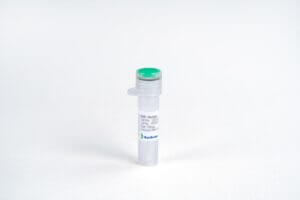
CD27 Ligand/CD70 Fc Chimera, Human
$1,293.75 Add to cart View Product DetailsCD70 (Cluster of Differentiation 70) is a protein that in humans is encoded by CD70 gene. CD70 is a ligand for CD27. The CD70-CD27 pathway plays an important role in the generation and maintenance of T cell immunity, in particular during antiviral responses. Upon CD27 binding, induces the proliferation of costimulated T-cells and enhances the generation of cytolytic T-cells.The CD70 protein is expressed on highly activated lymphocytes (like in T- and B-cell lymphomas). It is therefore suggested that anti-CD70 antibodies might be a possible treatment for CD70 positive lymphomas as normal lymphocytes have low CD70 expression.
-

CD27 Ligand/CD70 Fc Chimera, Human
$189.75 Add to cart View Product DetailsCD70 (Cluster of Differentiation 70) is a protein that in humans is encoded by CD70 gene. CD70 is a ligand for CD27. The CD70-CD27 pathway plays an important role in the generation and maintenance of T cell immunity, in particular during antiviral responses. Upon CD27 binding, induces the proliferation of costimulated T-cells and enhances the generation of cytolytic T-cells.The CD70 protein is expressed on highly activated lymphocytes (like in T- and B-cell lymphomas). It is therefore suggested that anti-CD70 antibodies might be a possible treatment for CD70 positive lymphomas as normal lymphocytes have low CD70 expression.
-

CD28 Fc Chimera, Human
$1,035.00 Add to cart View Product DetailsHuman CD28 is composed of four exons encoding a protein of 220 amino acids that is expressed on the cell surface as a glycosylated, disulfide-linked homodimer of 44 kDa. Members of the CD28 family share a number of common features. These receptors consist of paired V-set immunoglobulin superfamily (IgSF) domains attached to single transmembrane domains and cytoplasmic domains that contain critical signaling motifs. The CD28 and CTLA4 ligands, CD80 and CD86, consist of single V-set and C1-set IgSF domains. The interaction of these costimulatory receptors with ligands is mediated through the MYPPPY motif within the receptor V-set domains. CD28 is expressed constitutively on almost all human CD4 T cells and approximately 50% of CD8 T cells. CD28 costimulation has diverse effects on T cell function, including biochemical events at the immunological synapse, downstream phosphorylation and other post-translational modifications, transcriptional changes, and cytoskeletal remodeling. At the most basic level, CD28 signals increase a cell’s glycolytic rate, allowing cells to generate the energy necessary for growth and proliferation.



